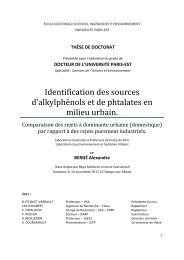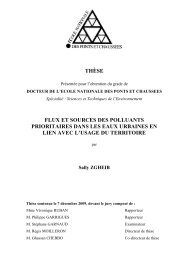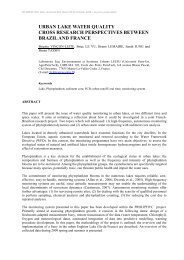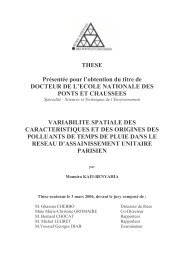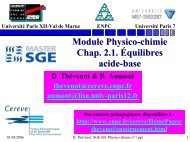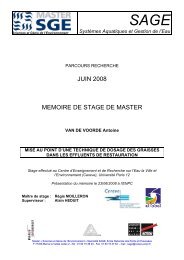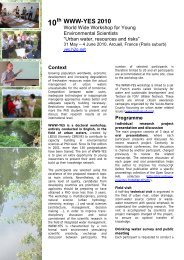View - ResearchGate
View - ResearchGate
View - ResearchGate
You also want an ePaper? Increase the reach of your titles
YUMPU automatically turns print PDFs into web optimized ePapers that Google loves.
12 "Appropriate technologies" for drinking watersupply in developing countries.C. C. Dorea*INTRODUCTION* Department of Civil Engineering, University of Glasgow, Rankine Building,Oakfield Ave., G12 8LT, United Kingdom(E-mail: caetanodorea@hotmail.com, dorea@civil.gla.ac.uk)AbstractIn order to ensure maximum consumer benefits (e.g. public health, livelihood),drinking water supply technologies in developing countries should be adopted takinginto consideration locally available skills, resources as well as cultural andenvironmental settings. This paper presents case-studies from several developingcountries in different geographical regions of water supply projects utilizing methodsranging from biological treatment offered slow sand filtration systems to chemicallyassistedclarification. These examples reveal successes and lessons learnt in severalresearch projects conducted under different settings (e.g. international developmentand humanitarian emergencies). In addition, the importance of capacity building forsuccessful implementation of water treatment technologies is also illustrated.KeywordsAppropriate technology; coagulation; development; emergencies; slow sand filtration;water treatmentHealth risks associated with drinking-water, particularly microbial, are a major concern inwater treatment. Particularly in developing countries where resources for a minimally adequateand reliable water supply are many times lacking. Therefore, drinking water treatment andsupply projects should make the most of the accessible resources by adopting the mostadequate technologies available. The term “appropriate technology” is commonly used in thecontext of water treatment and supply in developing countries to refer to water purificationtechniques that can be implemented (sometimes), operated, and maintained by the beneficiarycommunity.Appropriate technology usually refers to situations where there is a relative stability and timefor the involvement and capacity building of the local community (i.e. development projects).Locals are consulted on their preference of technology and factors such as locally availableskills and resources are taken into consideration together with the cultural and environmentalsettings. However, in situations such as humanitarian emergencies an appropriate technologymay refer to water treatment methods that can be quickly and easily implemented (usually by aforeign aid agency) in locations with limited resources (e.g. energy source, chemical supply,spare parts).Three case studies are presented on use of appropriate technologies for water treatment indeveloping countries, varying from rural community slow sand filtration systems tochemically-assisted emergency water treatment kits. Both successes and lessons learnt areillustrated in each case study from varied geographical locations (i.e. Sub-Saharan Africa,South Asia, and South-East Asia) and contexts (i.e. development and humanitarianemergency).CASE STUDY 1: MULTI-STAGE FILTRATION IN RWANDAMulti-stage filtrationSlow sand filtration (SSF) has been well established as a biological process for drinking-watertreatment that can achieve significant improvements in water quality. However, it is sensitiveto influent waters of high turbidity. This limitation has the implication of hindering thereliability of the process in terms of continuity or negative effects on the biological activity.This shortcoming to SSF can be dealt with the incorporation of pre-treatment stages. Gravel(or roughing) pre-filters are units filled with gradually finer graded media with varying beddepths (or lengths). They have been used together with SSF due to their effectiveness,simplicity, and reliability as pre-treatment, providing (together with SSF) a multiple-barriersystem; otherwise know as multi-stage filtration (MSF) systems. Such a treatment approachrelies on more than one purification stage (or barrier) during the treatment processprogressively removing contaminants and consistently producing safe and wholesome water(Galvis et al., 1994).Study areaThe study area is situated in the communities of Nyabwishongwezi and Ntoma in northeast ofthe country bordering Uganda and Tanzania. The two multi-stage filtration (MSF) watertreatment plants (WTPs) are located in a hilly terrain and utilize the river Umuvumba that runsthrough the boarder of Uganda and Rwanda. The Nyabwishongwezi WTP is a multi-stagefiltration plant consisting of four parallel storage tanks followed by two parallel two-stagegravel (roughing) pre-filters and four parallel slow sand filter units. Choice of such treatmentsystem was based on the inadequacy of groundwater as a source in terms of quality and quality(i.e. high iron content). This WTP was designed for a population of 18000, mainly returneesfrom the 1994 genocide. The neighboring Ntoma WTP was commissioned by a different nongovernmentalorganization (NGO) shortly after the construction of the NyabwishongweziWTP. It is said to have been a “blueprint copy” of the Nyabwishongwezi WTP; mainlydiffering in the fact that the water is pumped from the river intake to conventional rectangular(horizontal-flow) sedimentation basins, in contrast to the batch (i.e. fill-draw) storage tanks ofthe Nyabwishongwezi WTP. This is followed by two-stage up-flow gravel pre-filters and slowsand filters.Field visit outcomes/findingsDespite having no terminal disinfection, the finished water produced by the MSF system inNyabwishongwezi was substantially better in terms of turbidity and microbiological quality incomparison to the polluted source water (Figure 1). The water quality assessment was done inconjunction with the plant operating staff that received water quality training during the firstfield visit to the system in 2002. However, some design/operational problems were also noted(Bertrand et al., 2003; Dorea et al., 2004), some of which could be simply remedied (e.g.floating outlets to storage tanks, drainage system for gravel pre-filter cleaning); while otherswould require a substantial investment (e.g. adequate intake structure, insufficient number ofgravel pre-filter units).WWW-YES 2008, Paris 13 – 16 May 2008 105WWW-YES 2008, Paris 13 – 16 May 2008 106



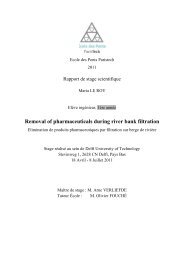
![[pastel-00730831, v1] Incidence des pratiques d'entretien ... - LEESU](https://img.yumpu.com/50938896/1/184x260/pastel-00730831-v1-incidence-des-pratiques-dentretien-leesu.jpg?quality=85)

